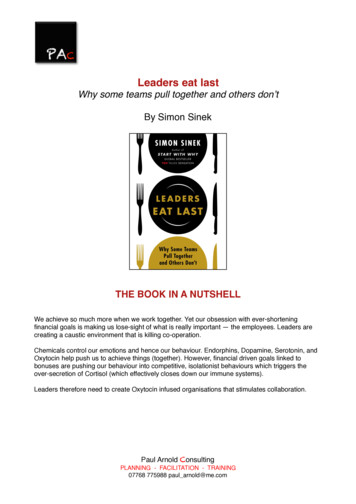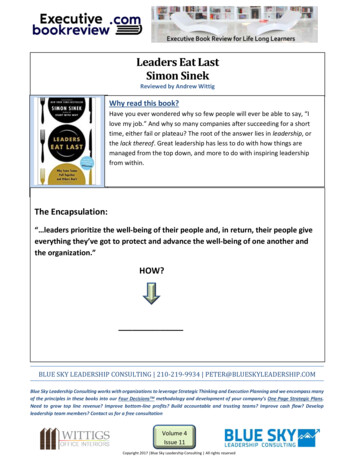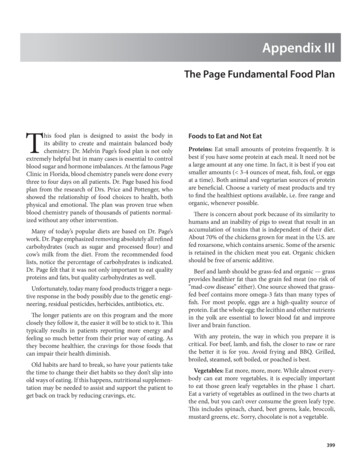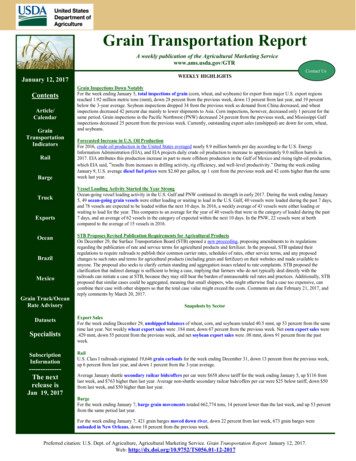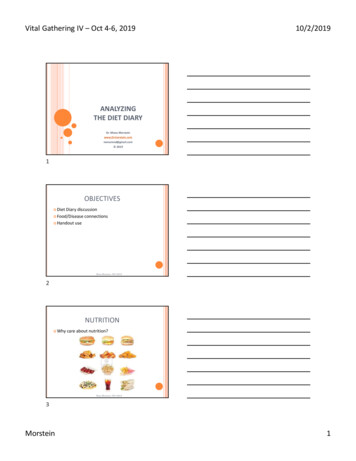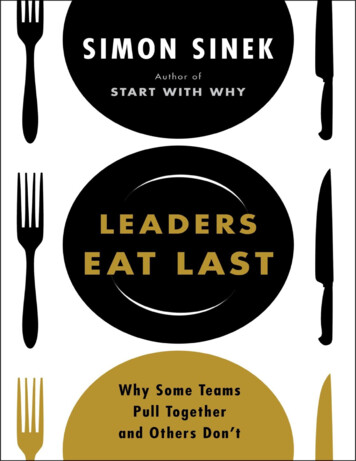
Transcription
ALSO BY THE AUTHORStart with Why: How Great Leaders Inspire Everyone to Take Action
PORTFOLIO / PENGUINPublished by the Penguin GroupPenguin Group (USA) LLC375 Hudson StreetNew York, New York 10014USA Canada UK Ireland Australia New Zealand India South Africa Chinapenguin.comA Penguin Random House CompanyFirst published by Portfolio / Penguin, a member of Penguin Group (USA) LLC, 2013Copyright 2014 by SinekPartners LLCPenguin supports copyright. Copyright fuels creativity, encourages diverse voices, promotes freespeech, and creates a vibrant culture. Thank you for buying an authorized edition of this bookand for complying with copyright laws by not reproducing, scanning, or distributing any part ofit in any form without permission. You are supporting writers and allowing Penguin to continueto publish books for every reader.“This Be the Verse” from The Complete Poems of Philip Larkin, edited by Archie Burnett.Copyright 2012 by The Estate of Philip Larkin. Reprinted by permission of Farrar, Straus andGiroux, LLC and Faber and Faber Ltd.Library of Congress Cataloging-in-Publication DataSinek, Simon.Leaders eat last : why some teams pull together and others don’t / Simon Sinek.pages cmIncludes index.ISBN 978-1-101-62303-91. Leadership. 2. Corporate culture. 3. Organizational change. I. Title.HD57.7.S5487 2014658.4'092—dc232013039108While the author has made every effort to provide accurate telephone numbers, Internetaddresses, and other contact information at the time of publication, neither the publisher nor theauthor assumes any responsibility for errors, or for changes that occur after publication. Further,publisher does not have any control over and does not assume any responsibility for author orthird-party Web sites or their content.Version 1
To the men and women I’ve met in the United States Air Force—You have taught me more about what it means to be human than anyonewho wears a suit ever did.
CONTENTSAlso By The AuthorTitle PageCopyrightDedicationEpigraphForewordPART 1: OUR NEED TO FEEL SAFE1. Protection from Above2. Employees Are People Too3. Belonging4. Yeah, but . . .PART 2: POWERFUL FORCES5. When Enough Was Enough6. E.D.S.O.7. The Big C8. Why We Have LeadersPART 3: REALITY9. The Courage to Do the Right Thing10. Snowmobile in the DesertPART 4: HOW WE GOT HERE11. The Boom Before the Bust
12. The Boomers All Grown UpPART 5: THE ABSTRACT CHALLENGE13. Abstraction Kills14. Modern Abstraction15. Managing the Abstraction16. ImbalancePART 6: DESTRUCTIVE ABUNDANCE17. Leadership Lesson 1: So Goes the Culture, so Goes the Company18. Leadership Lesson 2: So Goes the Leader, so Goes the Culture19. Leadership Lesson 3: Integrity Matters20. Leadership Lesson 4: Friends Matter21. Leadership Lesson 5: Lead the People, Not the NumbersPART 7: A SOCIETY OF ADDICTS22. At the Center of All Our Problems Is Us23. At Any Expense24. The Abstract GenerationPART 8: BECOMING A LEADER25. Step 1226. Shared Struggle27. We Need More LeadersAcknowledgmentsNotesBibliographyIndex
Leaders are the ones who run headfirst into the unknown.They rush toward the danger.They put their own interests aside to protect us or to pull us into the future.Leaders would sooner sacrifice what is theirs to save what is ours.And they would never sacrifice what is ours to save what is theirs.This is what it means to be a leader.It means they choose to go first into danger, headfirst toward the unknown.And when we feel sure they will keep us safe,we will march behind them and work tirelessly to see their visions come tolifeand proudly call ourselves their followers.
FOREWORDof no case study in history that describes an organization that hasI knowbeen managed out of a crisis. Every single one of them was led. Yet agood number of our educational institutions and training programs todayare focused not on developing great leaders but on training effectivemanagers. Short-term gains are viewed as the mark of success and longterm organizational growth and viability are simply the bill payers.Leaders Eat Last is an effort to change this paradigm.In Leaders Eat Last, Simon Sinek does not propose any new leadershiptheory or core principle. He has a much higher purpose to his writing.Simon would like to make the world a better place for all of us. His visionis simple: to create a new generation of men and women who understandthat an organization’s success or failure is based on leadership excellenceand not managerial acumen.It is not an accident that Simon uses the U.S. military, and in particularthe United States Marine Corps, to explain the importance of leaders beingfocused on their people. These organizations have strong cultures andshared values, understand the importance of teamwork, create trust amongtheir members, maintain focus, and, most important, understand theimportance of people and relationships to their mission success. Theseorganizations are also in a position where the cost of failure can becatastrophic. Mission failure is not an option. Without a doubt, peopleenable the success of all our military services.When you are with Marines gathering to eat, you will notice that themost junior are served first and the most senior are served last. When youwitness this act, you will also note that no order is given. Marines just doit. At the heart of this very simple action is the Marine Corps’ approach to
leadership. Marine leaders are expected to eat last because the true priceof leadership is the willingness to place the needs of others above yourown. Great leaders truly care about those they are privileged to lead andunderstand that the true cost of the leadership privilege comes at theexpense of self-interest.In his previous book, Start with Why: How Great Leaders InspireEveryone to Take Action, Simon explained that for an organization to besuccessful its leaders need to understand the true purpose of theirorganization—the Why. In Leaders Eat Last, Simon takes us to the nextlevel of understanding why some organizations do better than others. Hedoes this by detailing all elements of the leadership challenge. Simplystated, it is not enough to know “the Why” of your organization; you mustknow your people and realize that they are much more than an expendableresource. In short, professional competence is not enough to be a goodleader; good leaders must truly care about those entrusted to their care.Good management is clearly not enough to sustain any organizationover the long term. Simon’s in-depth explanation of the elements ofhuman behavior clearly demonstrates that there are real reasons why someorganizations may do well over a short period of time but eventually fail:The leadership has failed to create an environment where people really domatter. As Simon points out, organizations where people share values andare valued succeed over the long term in both good and bad times.John Quincy Adams would have understood Simon’s message becausehe clearly understood what it was to be a leader when he stated: “If youractions inspire others to dream more, learn more, do more and becomemore, you are a leader.” In this quote, I think you will find the message ofLeaders Eat Last. When leaders inspire those they lead, people dream of abetter future, invest time and effort in learning more, do more for theirorganizations and along the way become leaders themselves. A leader whotakes care of their people and stays focused on the well-being of theorganization can never fail. My hope is that after reading this book readerswill be inspired to always eat last.GEORGE J. FLYNN,Lieutenant General, U.S. Marine Corps (Ret.)
[ OUR NEED TO FEEL SAFE ]CHAPTER 1Protection from Abovelayer of clouds blocked out any light. There were no stars andA thickthere was no moon. Just black. The team slowly made its way throughthe valley, the rocky terrain making it impossible to go any faster than asnail’s pace. Worse, they knew they were being watched. Every one ofthem was on edge.A year hadn’t yet passed since the attacks of September 11. TheTaliban government had only recently fallen after taking a pounding fromU.S. forces for their refusal to turn over the Al Qaeda leader, Osama binLaden. There were a lot of Special Operations Forces in the areaperforming missions that, to this day, are still classified. This was one ofthose teams and this was one of those missions.All we know is that the team of twenty-two men was operating deepinside enemy territory and had recently captured what the governmentcalls a “high-value target.” They were now working their way through adeep valley in a mountainous part of Afghanistan, escorting their highvalue target to a safe house.Flying over the thick clouds that night was Captain Mike Drowley, orJohnny Bravo, as he is known by his call sign or nickname. Except for thewhir of his engines, it was perfectly peaceful up there. Thousands of starsspeckled the sky, and the moon lit up the top of the clouds so brightly itlooked like a fresh layer of snow had fallen. It was beautiful.Johnny Bravo and his wingman were circling above in their A-10aircraft, waiting should they be needed below. Affectionately known as theWarthog, the A-10 is not technically a fighter jet; it’s an attack aircraft. A
relatively slow-flying, single-seat armored plane designed to provide closeair support for troops on the ground. Unlike other fighter jets, it is not fastor sexy (hence the nickname), but it gets the job done.Ideally, both the A-10 pilots in the air and the troops on the groundwould prefer to see each other with their eyes. Seeing the plane above,knowing someone is looking out for them, gives the troops below a greatersense of confidence. And seeing the troops below gives the pilots a greatersense of assurance that they will be able to help if needed. But given thethick cloud cover and the mountainous terrain that night in Afghanistan,the only way either knew the other was there was through the occasionalradio contact they kept. Without a line of sight, Johnny Bravo couldn’t seewhat the troops saw, but he could sense how the troops felt from what heheard over the radio. And this was enough to spur him to act.Following his gut, Johnny Bravo decided he needed to execute aweather letdown, to drop down below the clouds so he could take a look atwhat was happening on the ground. It was a daring move. With the thick,low-hanging clouds, scattered storms in the area and the fact that JohnnyBravo would have to fly into a valley with his field of vision reduced bythe night-vision goggles, performing the weather letdown under theseconditions was extremely treacherous for even the most experienced ofpilots.Johnny Bravo was not told to perform the risky maneuver. If anything,he probably would have been told to hang tight and wait until he got thecall to help. But Johnny Bravo is not like most pilots. Even though he wasthousands of feet above in the safe cocoon of his cockpit, he could sensethe anxiety of the men below. Regardless of the dangers, he knew thatperforming the weather letdown was the right thing to do. And for JohnnyBravo, that meant there was no other choice.Then, just as he was preparing to head down through the clouds intothe valley, his instincts were confirmed. Three words came across theradio. Three little words that can send shivers down a pilot’s neck: “Troopsin contact.”“Troops in contact” means someone on the ground is in trouble. It isthe call that ground forces use to let others know they are under attack.Though Johnny Bravo had heard those words many times before during
training, it was on this night, August 16, 2002, that he heard the words“troops in contact” for the first time in a combat situation.Johnny Bravo had developed a way to help him relate to the men onthe ground. To feel what they feel. During every training exercise, whileflying above the battlefield, he would always replay in his mind the scenefrom the movie Saving Private Ryan when the Allies stormed the beachesof Normandy. He would picture the ramp of a Higgins boat dropping down,the men running onto the beach into a wall of German gunfire. The bulletswhizzing past them. The pings of stray shots hitting the steel hulls of theboats. The cries of men hit. Johnny Bravo had trained himself to imaginethat that was the scene playing out below every time he heard “Troops incontact.” With those images vividly embossed in his mind, Johnny Bravoreacted to the call for assistance.He told his wingman to hang tight above the clouds, announced hisintentions to the flight controllers and the troops below and pointed hisaircraft down into the darkness. As he passed through the clouds, theturbulence thrashed him and his aircraft about. A hard push to the left. Asudden drop. A jolt to the right. Unlike the commercial jets in which wefly, the A-10 is not designed for passenger comfort, and his plane bouncedand shook hard as he passed through the layer of cloud.Flying into the unknown with no idea what to expect, Johnny Bravofocused his attention on his instruments, trying to take in as muchinformation as he could. His eyes moved from one dial to the nextfollowed by a quick glance out the front window. Altitude, speed, heading,window. Altitude, speed, heading, window. “Please. Let. This. Work.Please. Let. This. Work,” he said to himself under his breath.When he finally broke through the clouds, he was less than a thousandfeet off the ground, flying in a valley. The sight that greeted him wasnothing like he had ever seen before, not in training or in the movies.There was enemy fire coming from both sides of the valley. Massiveamounts of it. There was so much that the tracer fire—the streaks of lightthat follow the bullets—lit up the whole area. Bullets and rockets allaimed at the middle, all aimed squarely at the Special Operations Forcespinned down below.In 2002 the avionics in the aircraft were not as sophisticated as theyare today. The instruments Johnny Bravo had couldn’t prevent him from
hitting the mountain walls. Worse, he was flying with old Soviet maps leftover from the invasion of Afghanistan in the 1980s. But there was no wayhe was going to let down those troops. “There are fates worse than death,”he will tell you. “One fate worse than death is accidentally killing yourown men. Another fate worse than death is going home alive when twentytwo others don’t.”And so, on that dark night in August, Johnny Bravo started counting.He knew his speed and he knew his distance from the mountains. He didsome quick calculations in his head and counted out loud the seconds hehad before he would hit the valley walls. “One one thousand, two onethousand, three one thousand . . .” He locked his guns onto a position fromwhich he could see a lot of enemy fire originating and held down thetrigger of his Gatling gun. “Four one thousand, five one thousand, six onethousand . . .” At the point he ran out of room, he pulled back on the stickand pulled a sharp turn. His plane roared as he pulled back into the cloudabove, his only option to avoid smacking into the mountain. His bodypressed hard into his seat from the pressure of the G-forces as he set to goaround again.But there was no sound on the radio. The silence was deafening. Didthe radio silence mean his shots were useless? Did it mean the guy on theradio was down? Or worse, did it mean the whole team was down?Then the call came. “Good hits! Good hits! Keep it coming!” And keepit coming he did. He took another pass, counting again to avoid hitting themountains. “One one thousand, two one thousand, three one thousand . . .”And another sharp turn and another run. And another. And another. He wasmaking good hits and he had plenty of fuel; the problem now was, he wasout of ammo.He pointed his plane up to the clouds to fly and meet his wingman,who was still circling above. Johnny Bravo quickly briefed his partner onthe situation and told him to do one thing, “Follow me.” The two A-10s,flying three feet apart from each other, wing to wing, disappeared togetherinto the clouds.When they popped out, both less than a thousand feet above theground, they began their runs together. Johnny Bravo did the counting andhis wingman followed his lead and laid down the fire. “One one thousand.Two one thousand. Three one thousand. Four one thousand . . .” On cue,
the two planes pulled high-G turns together and went around again andagain and again. “One one thousand. Two one thousand. Three onethousand. Four one thousand.”That night, twenty-two men went home alive. There were no Americancasualties.The Value of EmpathyTHAT AUGUST NIGHT overAfghanistan, Johnny Bravo risked his life so thatothers might survive. He received no performance bonus. He didn’t get apromotion or an award at the company off-site. He wasn’t looking for anyundue attention or reality TV show for his efforts. For Johnny Bravo, itwas just part of the “J.O.B.” as he puts it. And the greatest reward hereceived for his service was meeting the forces for whom he provided topcover that night. Though they had never met before, when they finally didmeet, they hugged like old friends.In the linear hierarchies in which we work, we want the folks at the topto see what we did. We raise our hands for recognition and reward. Formost of us, the more recognition we get for our efforts from those incharge, the more successful we think we are. It is a system that works solong as that one person who supervises us stays at the company and feelsno undue pressure from above—a nearly impossible standard to maintain.For Johnny Bravo and those like him, the will to succeed and the desire todo things that advance the interests of the organization aren’t justmotivated by recognition from above; they are integral to a culture ofsacrifice and service, in which protection comes from all levels of theorganization.There is one thing that Johnny Bravo credits for giving him thecourage to cross into the darkness of the unknown, sometimes with theknowledge that he might not come back. And it’s not necessarily what youwould expect. As valuable as it was, it isn’t his training. And for all theadvanced schooling he has received, it isn’t his education. And asremarkable as the tools are that he has been given, it isn’t his aircraft orany of its sophisticated systems. For all the technology he has at his
disposal, empathy, Johnny Bravo says, is the single greatest asset he has todo his job. Ask any of the remarkable men and women in uniform who riskthemselves for the benefit of others why they do it and they will tell youthe same thing: “Because they would have done it for me.”Where do people like Johnny Bravo come from? Are they just bornthat way? Some perhaps are. But if the conditions in which we work meeta particular standard, every single one of us is capable of the courage andsacrifice of a Johnny Bravo. Though we may not be asked to risk our livesor to save anybody else’s, we would gladly share our glory and help thosewith whom we work succeed. More important, in the right conditions, thepeople with whom we work would choose to do those things for us. Andwhen that happens, when those kinds of bonds are formed, a strongfoundation is laid for the kind of success and fulfillment that no amount ofmoney, fame or awards can buy. This is what it means to work in a place inwhich the leaders prioritize the well-being of their people and, in return,their people give everything they’ve got to protect and advance the wellbeing of one another and the organization.I use the military to illustrate the example because the lessons are somuch more exaggerated when it is a matter of life and death. There is apattern that exists in the organizations that achieve the greatest success,the ones that outmaneuver and outinnovate their competitors, the ones thatcommand the greatest respect from inside and outside their organizations,the ones with the highest loyalty and lowest churn and the ability toweather nearly every storm or challenge. These exceptional organizationsall have cultures in which the leaders provide cover from above and thepeople on the ground look out for each other. This is the reason they arewilling to push hard and take the kinds of risks they do. And the way anyorganization can achieve this is with empathy.
CHAPTER 2Employees Are People TooBefore there was empathy at the company, going to work felt like, well,work. On any given morning, the factory employees would stand attheir machines waiting to start at the sound of the bell. And when it rang,on cue they would flip the switches and power up the machines in front ofthem. Within a few seconds, the whir of the machinery drowned out thesound of their voices. The workday had begun.About two hours into the day, another bell would ring, announcing thetime the workers could take a break. The machines would stop and nearlyevery worker would leave their post. Some went to the bathroom. Somewent to grab another cup of coffee. And some just sat by their machines,resting until the bell told them to start work again. A few hours later, thebell would sound again, this time to let them know they were now allowedto leave the building for lunch. This was the way it had always been done.“I didn’t know any better,” said Mike Merck, an assembly team leaderwith a thick Southern drawl who had been with HayssenSandiacre forfourteen years. “I think anyone in the building would have told you thesame thing.”But things would change after Bob Chapman took over the SouthCarolina company. Chapman is CEO of the equally cumbersomely namedBarry-Wehmiller, a collection of predominantly manufacturing companiesthat Chapman had been steadily buying over the years. Most of thecompanies that Chapman bought were in distress. Their financials wereweak and, in some cases, their cultures were worse. HayssenSandiacre washis latest acquisition. Other CEOs may have brought with them a team ofconsultants and a new strategy, ready to tell everyone what they had to doto “return the company to profitability.” What Chapman brought, in stark
contrast, was a willingness to listen. As he did with every company heacquired, he started by sitting down to hear what employees had to say.Ron Campbell, a twenty-seven-year veteran of the company, had justreturned from three months in Puerto Rico, where he had been responsiblefor installing HayssenSandiacre’s manufacturing equipment in acustomer’s plant. Sitting in the room with Chapman, Campbell washesitant to talk about what life was like at the company. “First of all,”Campbell asked, “if I tell the truth, will I still have a job tomorrow?”Chapman smiled. “If you have any trouble tomorrow about what you saytoday,” he assured him, “you give me a call.”And with that, Campbell started to open up. “Well, Mr. Chapman,” hestarted, “it seems like you trust me a lot more when you can’t see me thanwhen I’m right here. I had more freedom while I was away at a customersite than I do here,” he said, referring to his time away in Puerto Rico. “Assoon as I stepped in the plant, it’s like all my freedom just slipped away. Itfeels like someone has their thumb on me. I had to punch a time clockwhen I walked in and again when I left for lunch, came back and when Iwas done for the day. I didn’t have to do that in Puerto Rico.” This wasnothing Chapman hadn’t heard before at other factories.“I walk in the same door with engineers, accountants and other peoplewho work in the office,” Campbell went on. “They turn left to go to theoffice and I go straight into the plant and we are treated completelydifferently. You trust them to decide when to get a soda or a cup of coffeeor take a break; you make me wait for a bell.”Others felt the same. It was like there were two different companies.No matter how much effort they put in, those who stood by the machinesdidn’t feel like the company trusted them simply because they stood on afactory floor instead of sitting at desks. If an office employee needed tocall home to let their kids know they would be late, they would simplypick up the phone and call them. On the factory floor, however, if a workerneeded to do the same thing, they had to ask permission to use the payphone.When Campbell finished, Chapman turned to the personnel leader andtold him they needed to take down the time clocks. The bells were to gotoo. Without making any grand proclamations and without asking for
anything in return from the employees, Chapman decided that things weregoing to be different from now on. And that was just the start.Empathy would be injected into the company and trust would be thenew standard. Preferring to see everyone as human instead of as a factoryworker or office employee, Chapman made other changes so that everyonewould be treated the same way.Spare machine parts had always been kept inside a locked cage. If aworker needed a part, they would have to stand in line outside the cage andask a parts employee to get what they needed. Workers were not allowed togo into the cage themselves. This was management’s way of protectingagainst theft. It may have prevented theft, but it was also a powerfulreminder that management didn’t trust people. Chapman ordered all thelocks removed and all the fences taken down and allowed any employee togo into the area to check out any part or tool they felt they needed.Chapman took out all the pay phones and made company phonesavailable that any employee could use at any time. No coins needed, nopermission required. Any employee would be allowed to go through anydoor and visit any part of the company whenever they wanted. Everyemployee would be treated the same way regardless of whether theyworked in the administrative offices or on the factory floor. This wasgoing to be the new normal.Chapman understood that to earn the trust of people, the leaders of anorganization must first treat them like people. To earn trust, he mustextend trust. He didn’t believe that simply because someone went tocollege or was good at accounting they were more trustworthy thansomeone who had a GED and was good with their hands. Chapmanbelieved in the fundamental goodness of people and he was going to treatthem as such.In a short period of time, the company started to feel more like afamily. Simply by changing the environment in which people worked, thesame people started acting differently toward each other. They felt likethey belonged and that enabled them to relax and feel valued. Peoplestarted to care for others as they felt cared for. This caring environmentallowed people to fully engage “their heads and hearts,” as Chapman likesto say, and the organization began to thrive.
An employee in the paint department faced a personal crisis. His wife,a diabetic, was going to lose her leg. He needed time to help her, but as anhourly worker, he could not afford to lose any pay. He couldn’t afford notto work. But this was a different company now. Without being asked, hisfellow employees quickly came up with a plan: to transfer their own paidvacation days so he could have more days off. Nothing like this had everbeen done before at the company. What’s more, it was in clear violation ofofficial company policy. But that didn’t matter. “We’re thinking aboutother people more,” Merck said. And so with the help of those in theadministrative office, that is exactly what they did.“I never thought you could enjoy a job,” said Campbell. “When youhave people who trust you, they’re going to do a better job for you to earnor keep that trust.” In the more than ten years since the chain-link fencecame down, there has been almost no theft. And if an employee has apersonal problem, they know the leaders of the company—and their fellowemployees—will be there for them.Employees didn’t just become more willing to help each other solveproblems, however. They also looked after their machines better. Thismeant fewer breakdowns and fewer work stoppages (which also meantexpenses were kept in check). The changes were not only good for thepeople, they were good for the company too. In the period since Chapmantook over, HayssenSandiacre saw revenue increase from 55 million to 95 million, which reflected organic and acquisition growth. They grewwithout any debt and without the help of a management consultant–drivenreorganization. The company grew because of the people who alreadyworked there. They had a renewed commitment to the organization, and itdidn’t come as a result of any promises of bonuses or threats. They weremore committed because they wanted to be. A new culture of caringallowed the people and strategies to flourish.This is what happens when the leaders of an organization listen to thepeople who work there. Without coercion, pressure or force, the peoplenaturally work together to help each other and advance the company.Working with a sense of obligation is replaced by working with a sense ofpride. And coming to work for the company is replaced by coming to workfor each other. Work is no longer a place to dread. It is a place to feelvalued.
We See What We Want to SeeCHAPMAN LIKES TO tellthe story about the first time he visitedHayssenSandiacre, which was five years before the transition that MikeMerck and Ron Campbell talk about. It was shortly after Chapman hadacquired the company. As the new CEO, no one knew who he was or paidany attention to him as he sipped a cup of coffee before his first meeting.They just went about their business as usual, waiting for the day to start.And it was what Chapman saw while sitting in the cafeteria that Marchmorning in 1997 that started his experiment with the company. He sawsomething he had never seen before in all of his years in business. It was ascene powerful enough to force him to reexamine nearly every lesson hehad ever learned about how to run a company. What he did atHayssenSandiacre would become the basis for how Chapman would runhis entire operation. More important, it would transform how he
leadership. Marine leaders are expected to eat last because the true price of leadership is the willingness to place the needs of others above your own. Great leaders truly care about those they are privileged to lead and understand that the true cost of the leadership privilege comes at the expense of self-interest.
